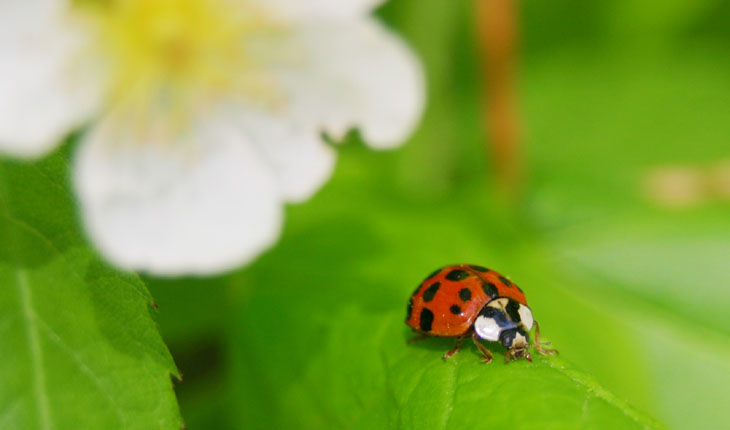
I didn’t initially intend it this way, but we’ve been working through a scale of increasing difficulty and effort in this series, starting with insects, then working through birds, then reptiles, and come finally to mammals. In my journeys, mammals have been the hardest to photograph and observe, for a number of reasons. So my first warning is, be patient, and be prepared for not seeing very much.
We tend to relate more to mammals, it appears, not perhaps for the least of which that we ourselves belong to that order, but to be honest, I think it’s more because mammals display both more apparent emotion through their eyes and expressions, and have more behavior that we recognize – or at least, think that we do. More on this shortly. First, our lists.
What do I need? This list is short, because mammal observation doesn’t benefit from many materials at all.
Flashlight. As before, a head-mounted one works better, and of course, spare batteries. Many mammals are far more active at night, so expect to spend some nights outside. Additionally, most mammals have reflective eyes, so a head-mounted flashlight provides a light source close to your own eyes, minimizing the reflection angle and increasing your likelihood of spotting something.
Appropriate clothing. The temperature often drops at night, and you may well be in rough country, so dress for trailblazing, with layers you can add or remove as needed. Since mammals rely on their noses to some extent, skip the perfumey detergents or softeners – and for that matter, cologne or scented toiletries on your body as well. Camouflage is better than, for instance, high-contrast clothing, but not absolutely necessary. The color vision of many mammals is limited in certain ways – not necessarily ‘color blindness,’ but often the inability to distinguish a wide range of colors. Usually, muted and darker colors are fine.
Measuring tape. Used for size of tracks and distance between, height of territorial marks, width of teeth marks, and the like. In a lot of cases, you’ll see more evidence of mammals than the mammals themselves, and this can help detail what, exactly, you’re seeing evidence of.
Collecting bags. Unlike the reptiles, these are used more for the evidence itself rather than collecting species. Usually ziplock plastic bags, film cans, or something similar work fine. In addition, tweezers or forceps for smaller or more gross items – you might actually be collecting feces for examination, if you’re serious ;-)
Binoculars. Again, good for identifying species from a distance, but not terribly high on the importance list – not like for birds.
The ability not to get lost. This is especially important if you’re trying to follow an animal trail at night. Orientation/trail skills, or a decent GPS unit, work very well here. I would add either area maps for the GPS, or a good knowledge ahead of time of the salient terrain features, like streams and ravines. These are distinct features that can tell you where you are, and direct you where you need to be. The typical topo maps, like the kind available from US Geological Survey, are often of limited use because they’re on a larger scale than a hiker can use. You’ll want fine detail.
Believe it or not, an identification guide is not really necessary, unless you’re trying to identify spoor (tracks, marks, feces.) Mammal species are usually quite distinct in an area, and easy to learn – most people can learn to tell a raccoon from an opossum pretty quickly ;-). And while identifying tracks can sometimes be useful, it requires terrain that leaves distinct tracks in the first place, like the mud at the edge of streams, or fine silty soil. Heavy forest, grasslands, and such terrain usually provide nothing to see, so while you might start tracking at a streamside, it becomes easy to lose the trail a short ways further on.
So, what am I looking for? Unlike the other classes we’ve covered, you’re likely to be doing as much detective work as you are actually seeing mammals, if not more. You’ll be looking for evidence that they’ve been around, especially if you’re doing anything in the day. This means tracks, trails through the tall grasses, feeding signs, freshly-dug small holes, and, occasionally, feces.
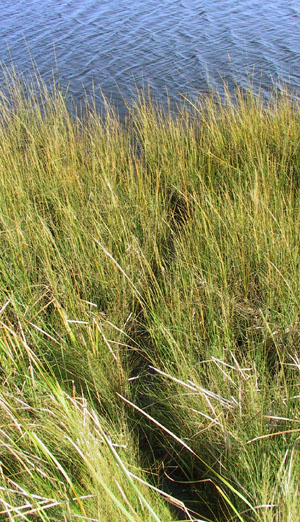 Start at the water. Everything needs water, but mammal species often leave the most distinct traces of their passing there. The fresher and more accessible, the better. Follow the edges of streams, looking for tracks and trails of flattened grass leading away. Also look for deposits of shells from molluscs and crayfish – this often indicates otters or raccoons. Steeper banks along deeper water often allows for entrances to beaver dens in the banks, but muskrats more often seek shallower areas because they eat grasses.
Start at the water. Everything needs water, but mammal species often leave the most distinct traces of their passing there. The fresher and more accessible, the better. Follow the edges of streams, looking for tracks and trails of flattened grass leading away. Also look for deposits of shells from molluscs and crayfish – this often indicates otters or raccoons. Steeper banks along deeper water often allows for entrances to beaver dens in the banks, but muskrats more often seek shallower areas because they eat grasses.
Spot the trails. Most times, this is simply an area of flattened grasses, so keep a sharp eye out. On the banks of water, you might see a smooth, cleared slide area often indicative of beavers – if so, you can often find anything from small sticks to limbs that have been cut, gnawed, or stripped of bark. Deer will often leave behind a large flattened section (about a meter across) in very deep grasses where they made their beds. However, wolves, foxes, raccoons, and opossums often have no trails at all, since they wander opportunistically looking for food.
In early mornings, occasionally you can find a very faint trail of overturned leaves, especially since they’ll have been damp on their undersides and this shows when disturbed. When the dewpoint arrived sometime in the night, occasionally a larger animal passing through high grass will have shaken off the dew there, leaving a very subtle trail that might be seen with the light at your back.
Listen! This is very important in spotting mammals. Their movements produce more sound than the others we’ve discussed, but it is still usually very subtle (the biggest exception, in my experience, is squirrels, which can produce a racket way out of proportion to their size.) The normal sounds of wind and such rarely produce little snaps or distinct rustles, so these are what you’re paying attention to. Freeze the moment you hear them and wait them out – if something is nearby, you’ll hear them again shortly. And of course, this means you can’t be sending your own signals, which animals are quite adept at listening for themselves, so you’ll be avoiding leaves, twigs, gravel, bubble wrap, and anything else that causes your feet to make noise. Find the bare patches or soft grasses, move slowly and gently, and pause very frequently.
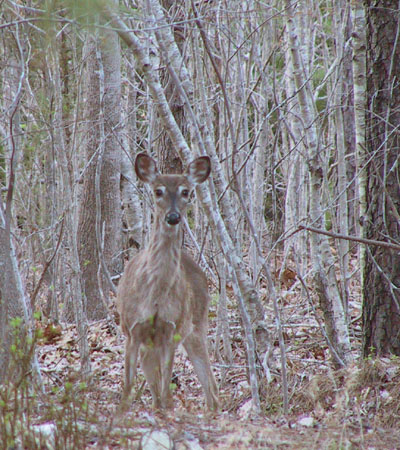 Look! Well, this is obvious, but there are some good habits to get into. Most especially, any time you’re about to leave an area of, for instance, screening trees or tall grasses, pause just inside the edge and scan the open areas very carefully. There’s nothing like bursting out into the open to scare off something you could have seen easily, which also means that sticking to edges and cover helps a lot more than crossing open fields. Watch those stream banks carefully, and look for those breaks in patterns. Most mammals are brown or greyish-brown to varying degrees, and can be distinguished from foliage with a sharp eye, but often not as easily as believed (I’m amazed at how well deer disappear even a few meters into wooded areas.)
Look! Well, this is obvious, but there are some good habits to get into. Most especially, any time you’re about to leave an area of, for instance, screening trees or tall grasses, pause just inside the edge and scan the open areas very carefully. There’s nothing like bursting out into the open to scare off something you could have seen easily, which also means that sticking to edges and cover helps a lot more than crossing open fields. Watch those stream banks carefully, and look for those breaks in patterns. Most mammals are brown or greyish-brown to varying degrees, and can be distinguished from foliage with a sharp eye, but often not as easily as believed (I’m amazed at how well deer disappear even a few meters into wooded areas.)
Patience. When you know you’re in an area that sees frequent activity, or hear something, or simply know it’s a good area, this is where you wait it out. Get comfortable if you can, and a camo blind or anything that screens your own subtle movements can help here, and of course, being in shade works better. The longer you can wait, the more you’ll be able to see. Animals that were alerted to your presence when you arrived have time to relax and reappear. Being on a slope or rise above good areas lets you have a much better view, but also be aware of what you look like yourself, and don’t silhouette yourself against the sky or something that shows your contrast. When photographing, you’re going to pick areas that give you a clear field of view and a good background, uncluttered and photogenic, preferably giving you something that contrasts from your chosen subjects to help them stand out.
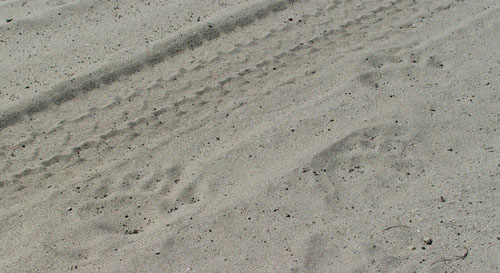
Scat. Or poop, if you prefer. This can also be used to identify what’s been visiting, and gives a better indication of how recently than tracks will, but for reasons mysterious, you may not want to mess with it. Knowing the basic types helps a lot, however: deer, rabbit, raccoon, fox, and so on. If you’re unsure, poking through it (a stick, at least, is recommended) can reveal what the animal has been eating recently, through the presence of small bones, seeds, grains, et cetera. Of course, this means you must know what diet the species has as well.
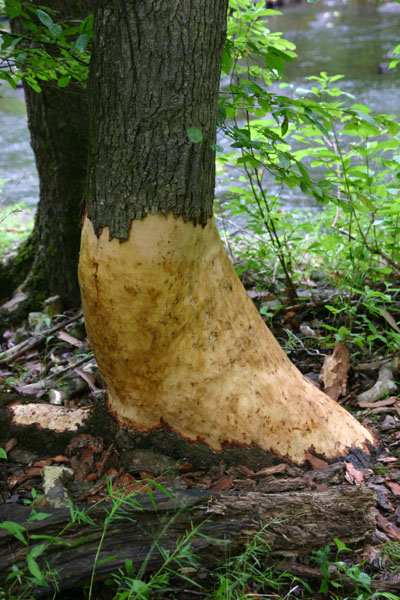 Other signs. This might mean small holes dug into soft ground (or an excavated beehive,) saplings with small branches nibbled off, deposits of mollusc shells, patches of fur or feathers in one spot, and so on. Again, for these to mean something, you have to know what’s in your area and what its habits are. Many people think deer graze, like cows, but they browse instead, eating new shoots and saplings, berries, garden plants, and the like. They’ll strip off soft bark from saplings, but bucks (males) will also score it with their rack to mark territory and clear the velvet off new horns. A cluster of fur or a patch of feathers often denotes fox or wolf ate something there, but smaller cases might indicate raccoon or opossum, and sometimes either is an indication of birds-of-prey instead – it can be very tricky to tell which. Beavers and muskrats do not touch fish, being strictly vegetarian, so finding something that’s been feeding on molluscs and shellfish means raccoons and otters, most likely (I admit I’m sticking to North American species here from experience.) Beaver signs are easy to find, consisting of the obvious felled trees, but also twigs stripped of bark, especially floating or with a series of crosswise teethmarks, trees with bark stripped off up to half a meter off the ground, and of course, dams. In my area, there are virtually no lodges; instead, the beavers live in the banks, often under tree roots.
Other signs. This might mean small holes dug into soft ground (or an excavated beehive,) saplings with small branches nibbled off, deposits of mollusc shells, patches of fur or feathers in one spot, and so on. Again, for these to mean something, you have to know what’s in your area and what its habits are. Many people think deer graze, like cows, but they browse instead, eating new shoots and saplings, berries, garden plants, and the like. They’ll strip off soft bark from saplings, but bucks (males) will also score it with their rack to mark territory and clear the velvet off new horns. A cluster of fur or a patch of feathers often denotes fox or wolf ate something there, but smaller cases might indicate raccoon or opossum, and sometimes either is an indication of birds-of-prey instead – it can be very tricky to tell which. Beavers and muskrats do not touch fish, being strictly vegetarian, so finding something that’s been feeding on molluscs and shellfish means raccoons and otters, most likely (I admit I’m sticking to North American species here from experience.) Beaver signs are easy to find, consisting of the obvious felled trees, but also twigs stripped of bark, especially floating or with a series of crosswise teethmarks, trees with bark stripped off up to half a meter off the ground, and of course, dams. In my area, there are virtually no lodges; instead, the beavers live in the banks, often under tree roots.
Interpreting behavior. This is actually much harder to do than it would seem, but because we tend to have a greater affinity for mammals than for birds or reptiles (or insects, imagine that,) we often fall for the trap that we know what they’re thinking, or what some particular aspect of behavior means. Yet, we may live around domesticated dogs or cats all of our lives and still not know what certain behaviors mean – we just think that we do. Virtually no animal thinks like us, or has the slightest reason to, and they all have their own particular social interactions. It’s best to simply keep very specific notes, remaining aware of all that you can, and leave the interpretations as mere speculation.
Imitation. I’ve mentioned this elsewhere, but many animals rely more on the behavior of other species, including us, than appearances. What this means is that behaving like a deer is actually more reassuring to a deer than looking like one. We have a wicked tendency to stop and stare when we see something, but this is actually predatory behavior, and often sends all kinds of warning signs to mammals (and birds too.) However, I have crept closer to deer and herons by imitating their behavior, especially that which sends the message that everything is cool. For herons, this was slow, lazy gazing around at the surroundings, careful steps in the shallow water, and preening behavior – yes, really; I was ducking, shrugging, and lifting my ‘wing’ to get at the ‘feathers’ on my side, and walked within 4 or 5 meters of a Great Blue Heron in Florida. For deer, this meant dipping my head low while wandering around slowly, examining the ground rather than them, and moving closer at an oblique angle rather than directly. It’s startling how well this can work, but overall, should only be attempted once you’ve already been spotted. Remaining motionless is still the best way to prevent discovery.
 Stay safe! This must go hand-in-hand with the sections above. As tempting as it may be to get nice close photos, or to have that “special encounter,” most mammals can do us a great deal of damage if so inclined. From my years of doing wildlife rescue and rehabilitation, I have a scar on my shoulder from a cute little grey squirrel that someone had tried to raise as a pet, and raccoons are a species that I’ll handle only with a net. We really don’t know what behavior, what circumstances, what line, constitutes a threat to most species and invites an aggressive response, and once it occurs we’re likely in no position to deal with it. This applies even to habituated animals in parks and refuges. So the cardinal rule is, keep your distance, and always have your escape route. Don’t keep pushing your luck by seeing just how close you can get, or by believing that since nothing has happened so far, this will continue to hold true. Most especially, animals with young should be left entirely alone (as in, leave the area,) and mating season is a time to remain very discreet. If any animal is staring at you, this is a warning sign, and walking up to you is very likely not a friendly gesture, but the test to see if you’re serious about invading their territory – the charge comes next. Relying on our human ideas of behavior is almost always a bad idea. Treat everything as if it’s an alien species from another planet, with unknown abilities and responses – this is the right attitude of respect and caution.
Stay safe! This must go hand-in-hand with the sections above. As tempting as it may be to get nice close photos, or to have that “special encounter,” most mammals can do us a great deal of damage if so inclined. From my years of doing wildlife rescue and rehabilitation, I have a scar on my shoulder from a cute little grey squirrel that someone had tried to raise as a pet, and raccoons are a species that I’ll handle only with a net. We really don’t know what behavior, what circumstances, what line, constitutes a threat to most species and invites an aggressive response, and once it occurs we’re likely in no position to deal with it. This applies even to habituated animals in parks and refuges. So the cardinal rule is, keep your distance, and always have your escape route. Don’t keep pushing your luck by seeing just how close you can get, or by believing that since nothing has happened so far, this will continue to hold true. Most especially, animals with young should be left entirely alone (as in, leave the area,) and mating season is a time to remain very discreet. If any animal is staring at you, this is a warning sign, and walking up to you is very likely not a friendly gesture, but the test to see if you’re serious about invading their territory – the charge comes next. Relying on our human ideas of behavior is almost always a bad idea. Treat everything as if it’s an alien species from another planet, with unknown abilities and responses – this is the right attitude of respect and caution.
To go along with that: Rabies is active in the mammal population across, at the least, the eastern seaboard of the US. The risks of this are often overstated, since it is no reason to avoid going out into the woods to look for mammals, but it does mean that you treat odd behavior as potentially dangerous. Most people think rabid animals are especially aggressive, but another trait of infection is the ‘dumb’ rabies, where animals are disoriented, slow, clumsy, and often spaced-out in appearance. This can give the impression of a sick or injured animal. Ditch the nurturing instincts and leave it be – call animal control as needed.
 Baby mammals: On occasion, you may come across what appears to be an orphaned or abandoned mammal, and feel this necessitates intervention. Once again, contact animal control or the local wildlife authority for your area (throughout the US, each state has a wildlife commission which will generally provide better resources than the federal US Fish & Wildlife Commission can – that’s how the jurisdiction breaks down.) And do this before you even pick up the animal – there are many circumstances where you should not interfere in any way. For instance, fawns instinctively stay put, laying down in tall grass while their mother forages, and may appear abandoned when this is business as usual. Many animal parents spring off at signs of danger, hoping to draw attention away from their young, and have not abandoned them at all.
Baby mammals: On occasion, you may come across what appears to be an orphaned or abandoned mammal, and feel this necessitates intervention. Once again, contact animal control or the local wildlife authority for your area (throughout the US, each state has a wildlife commission which will generally provide better resources than the federal US Fish & Wildlife Commission can – that’s how the jurisdiction breaks down.) And do this before you even pick up the animal – there are many circumstances where you should not interfere in any way. For instance, fawns instinctively stay put, laying down in tall grass while their mother forages, and may appear abandoned when this is business as usual. Many animal parents spring off at signs of danger, hoping to draw attention away from their young, and have not abandoned them at all.
Further, raising an orphan should never be attempted without proper education, and most states require specific permits to do this legally anyway. From having been in this field, I can’t stress this enough – it’s not as easy as it seems, and this is a wretched way of indulging your nurturing instincts. Mammal diets are specialized, and their behavior patterns as adults are, to some extent, established in their childhood; other behaviors come up naturally, and thus pets cannot be created just by getting them young. Rehabilitation takes education and experience, and the concern over an animal’s life should be the very reason not to attempt this on your own, since it’s far too easy to permanently, fatally affect an infant.
I’ll say it again: Mammal observation is often hard, and all the tips in the world won’t guarantee your ability to see something. You’ll have to work at it, and use patience, but most times it’s far more rewarding when you’re successful than with other types of animals. With luck, you’ll discover a situation where you can see frequent visits and start getting a good collection of observational notes, and perhaps some pics too.
Good luck!





















































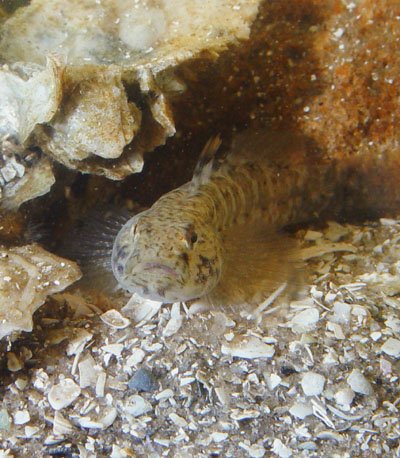 I feel obligated to let my four readers know that the blog
I feel obligated to let my four readers know that the blog  This is, unfortunately, a great example of a photo that’s far too busy – too many different things clashing together, preventing any strong focal point and destroying the uncluttered composition that every photographer should strive for. Given what I was after, though, there wasn’t much I could do about it, and catching the spray of water was the main accomplishment.
This is, unfortunately, a great example of a photo that’s far too busy – too many different things clashing together, preventing any strong focal point and destroying the uncluttered composition that every photographer should strive for. Given what I was after, though, there wasn’t much I could do about it, and catching the spray of water was the main accomplishment.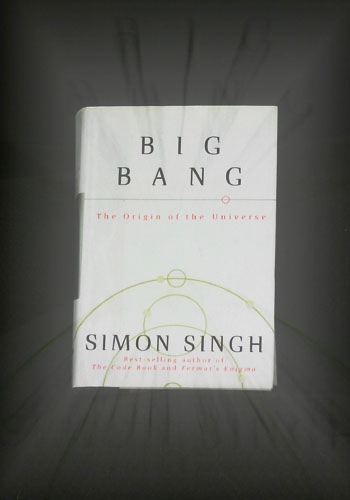

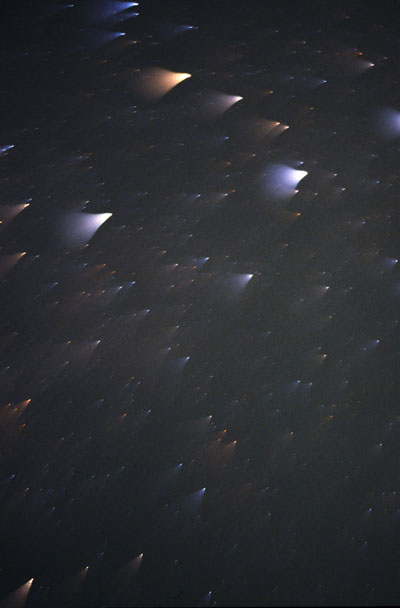 Reciprocity failure is where this breaks down. Due to the nature of the chemical reaction to light, low amounts of light don’t always register on film, and so lengthening the exposure has a reduced effect, with diminishing returns depending on the amount of light and length of exposure, often with a color shift because the different layers of emulsion have different sensitivities. Some films, like Fuji Provia 100, handle this fairly well, but Kodak Portra 400 is not among them. The images I have from that evening are all blue, grainy, and show almost no stars at all, much less meteor streaks. For the best opportunity I’ve ever had, I totally blew the pics. Even the spectacular airburst, which might have overcome the film’s flaws, was well away from the direction the camera was aimed at the time.
Reciprocity failure is where this breaks down. Due to the nature of the chemical reaction to light, low amounts of light don’t always register on film, and so lengthening the exposure has a reduced effect, with diminishing returns depending on the amount of light and length of exposure, often with a color shift because the different layers of emulsion have different sensitivities. Some films, like Fuji Provia 100, handle this fairly well, but Kodak Portra 400 is not among them. The images I have from that evening are all blue, grainy, and show almost no stars at all, much less meteor streaks. For the best opportunity I’ve ever had, I totally blew the pics. Even the spectacular airburst, which might have overcome the film’s flaws, was well away from the direction the camera was aimed at the time.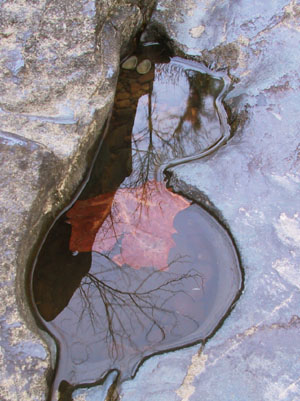 Yet, the photographer can only work with what’s present (we will ignore the studio photographer for the time being, and the select few who do digital composites and crap like that.) They’re handed a collection of elements almost totally out of their control, and they have to portray them in a manner that still produces a strong image. They usually cannot choose a background or foreground, and cannot leave out nonartistic elements except for selectively cropping them from the frame. They may wait for the right light, the right clouds in the sky, the right position or expression of their subject. They might seek a different vantage point that produces the right background or contrast (or reflection,) or use camera technique to purposefully blur or soften elements and draw attention to their subject. And in many cases, a particular aspect of their subject existed for fractions of a second only, and they had to anticipate this and capture it at its ideal time. Good photographers actually have to know something about art in the first place, in order to put all of the above actions to good use.
Yet, the photographer can only work with what’s present (we will ignore the studio photographer for the time being, and the select few who do digital composites and crap like that.) They’re handed a collection of elements almost totally out of their control, and they have to portray them in a manner that still produces a strong image. They usually cannot choose a background or foreground, and cannot leave out nonartistic elements except for selectively cropping them from the frame. They may wait for the right light, the right clouds in the sky, the right position or expression of their subject. They might seek a different vantage point that produces the right background or contrast (or reflection,) or use camera technique to purposefully blur or soften elements and draw attention to their subject. And in many cases, a particular aspect of their subject existed for fractions of a second only, and they had to anticipate this and capture it at its ideal time. Good photographers actually have to know something about art in the first place, in order to put all of the above actions to good use.